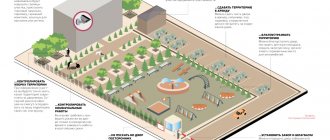Easement is a limited right to use the territory of a multi-unit residential building for passage, passage and repairs.
An easement is the right to limited use of someone else’s real estate (Article 274 of the Civil Code of the Russian Federation). It is transferred to another person by right of encumbrance. An easement is needed, for example, to lay a road or communications through someone else’s land and use them.
The party who received the easement does not take possession of the land, but can only use it, and for a specific purpose established by the contract or agreement. An easement is subject to mandatory state registration, without which it will not be considered concluded. Termination of the easement is also registered.
An easement can be temporary or permanent; private or public. A public easement is intended to ensure the interests of the state, local government or local population (Article 23 of the Land Code of the Russian Federation). A public easement can be established for:
- passage or passage through a land plot;
- repair of utility, engineering, electrical and other lines and networks, transport infrastructure facilities;
- carrying out drainage works and other purposes.
Let's look at a legal dispute about the establishment of an easement on the adjacent territory of an apartment building, which reached the Supreme Court of the Russian Federation (case No. A71 -4094/2020).
Can the local self-government not form a plot for an apartment building in the absence of money?
Article 48 of the Land Code of the Russian Federation. Grounds for termination of easement (current version)
1. An easement may be terminated on the grounds provided for by civil legislation.
2. A public easement, with the exception of a public easement established in the manner prescribed by Chapter V.7 of this Code, may be terminated in the absence of public needs for which it was established, by adopting an act of cancellation of the easement.
3. If the term of a public easement expires, it is considered terminated upon the expiration of the last day of the last month of the term of the public easement. In this case, a decision to terminate the public easement is not required.
4. A public easement established in the manner prescribed by Chapter V.7 of this Code is terminated on the basis of a decision of the authorized executive body or local government body that made the decision to establish a public easement, in cases where:
1) the activity for which a public easement has been established has not been carried out for two or more years;
2) within the period established by paragraph 2 of Article 39.46 of this Code, payment for the public easement established in relation to lands and (or) land plots that are in state or municipal ownership and not provided to citizens and (or) legal entities has not been paid;
3) payment has not been made for the public easement established in relation to land plots provided or owned by citizens and (or) legal entities:
within a period of more than six months from the date of receipt by the owner of the land plot of the draft agreement on the implementation of a public easement, if the payment for the public easement is paid in a one-time payment;
more than two times in a row after the expiration of the payment period established by the agreement on the implementation of a public easement, if the payment for the public easement is paid in periodic payments;
4) the owner of the public easement has abandoned it.
5. Upon the occurrence of the circumstances provided for in subparagraphs 1 and 2 of paragraph 4 of this article, a decision to terminate a public easement may be made by an authorized executive body of state power or a local government body provided for in Article 39.38 of this Code, independently or at the request of the owner of a land plot encumbered with a public easement. easement. The decision to terminate a public easement on the basis provided for in subparagraph 3 of paragraph 4 of this article is made by the authorized executive body or local government body provided for in Article 39.38 of this Code, upon the application of the owner of the land plot encumbered with the public easement.
6. The legal owner of a land plot has the right to demand termination of a public easement in court if the following grounds exist:
1) violation of the procedure for establishing a public easement;
2) the absence of the possibility of using a land plot and (or) a real estate object located on it or the occurrence of a significant difficulty in their use in accordance with their permitted use in connection with the implementation of a public easement, except for cases where the public easement is established for the purposes provided for in the article 39.37 of this Code;
3) changing the documentation on the planning of the territory, in accordance with which the public easement was established, providing for a different location of the engineering structure for the purpose of placing which the public easement was established, taking into account the period for transferring the specified engineering structure (if such a period exists);
4) the implementation by the owner of a public easement of the activity for which the public easement was established, in violation of the requirements of federal laws, technical regulations, other regulatory legal acts of the Russian Federation and (or) the conditions for the implementation of the public easement, provided for by the decision on the establishment of a public easement and (or) agreement on the implementation of a public easement;
5) in connection with the circumstances specified in subparagraphs 1 and 3 of paragraph 4 of this article.
An easement can be established for the passage of citizens through the territory of an apartment building to public places
At a general meeting, the owners of one of the apartment buildings in Izhevsk decided to install a fence with a gate around their yard. The management organization complied with this decision, having previously obtained all the necessary approvals and permits from the municipality.
But residents of the neighboring apartment building complained to the State Housing Authority: the fence blocked their pedestrian path to the public transport stop. The agency inspected the work of the management authority on the maintenance of the common property of the house around which the fence was installed.
The State Housing Supervision Authority came to the conclusion that the territory along which the pedestrian path was laid for residents of the surrounding apartment buildings is burdened with an easement. Owners cannot prevent other citizens from using a pedestrian path by blocking it. Consequently, the decision of the OSS to install the fence was made in violation of Part 5 of Art. 36 Housing Code of the Russian Federation.
The management authority received an order to notify the owners of the premises in the disputed apartment building that the fence violates the law, and to ensure passage through the adjacent territory of the apartment building.
The company filed a lawsuit, demanding that the order be declared illegal and unenforceable. According to the Civil Code of the Russian Federation and the Housing Code of the Russian Federation, owners of premises in apartment buildings have the right to make a decision at the OSS on fencing the local area, which is part of their common property. This is the exclusive competence of the general meeting. The decision was made with the necessary quorum present. When installing the fence, the UO received all the necessary permits. The company should not coordinate such work with residents of neighboring houses.
The State Housing Supervision Authority insisted that the fence creates an obstacle to the use of the pedestrian path. Persons who are not the owners of a land plot retain the right to use the objects on it if they were created before the date of entry into force of the Housing Code of the Russian Federation.
MKD land plot: maintenance and assessment of its sanitary condition
The GZHN body does not have the right to unilaterally establish an easement on a land plot of an apartment building
The outcome of the court case, confirmed by the Supreme Court of Russia, once again showed that Goszhilnadzor bodies cannot go beyond their powers.
The legislation states that an easement is established by the parties to the issue: the owner of the land and those who want to obtain restrictive rights, or the court. Neither the supervisory agency nor the municipal government has the right to unilaterally decide that an easement has been established on the local area. Also, residents of houses for whom the owners of the premises of a neighboring apartment building have blocked the usual path to the bus stop through their yard cannot claim this.
Previously, we wrote about a court case in which the appellate court pointed out that if the fence installed around the apartment building is located in the local area and its installation is agreed upon by the OSS and municipal authorities, then the fence is not illegal.
An obstacle to installing a fence cannot be the dissatisfaction of residents of neighboring houses, for whom this lengthens the path to a bus stop or store, or a unilateral decision by the State Housing Authority that the territory of the apartment building is burdened with an easement.
The Supreme Court indicated how to correctly establish an easement
Established judicial practice recognizes easement as an “extreme” measure that the parties can resort to in exceptional cases if there are no other ways to ensure unimpeded access to property, explains Land Law Firm Land Law Firm lawyer Federal Rating. group Land law/Commercial real estate/Construction group Dispute resolution in courts of general jurisdiction group Private capital group Arbitration proceedings (major disputes - high market) Company profile Marina Strokan. Vasily Ognev* faced a similar situation.
The cafe has closed access to the site
In 2003, he rented a plot of land in the city of Buturlinovka, Voronezh region, from the local administration for 49 years. On this land there was an old domestic building, which the tenant wanted to reconstruct and turn into an industrial premises for the repair of various equipment. It was this plan that Ognev agreed with the chief architect of the district, but was in no hurry to begin construction work. For several years the tenant did not appear on the land in Buturlinovka, and in 2021 he discovered that a cafe had been built in front of his plot.
Due to the new construction, Ognev lost free access to the building in which he wanted to organize a production facility. Then the tenant tried to negotiate with neighbor Inna Dmitrieva* to establish an easement and pass through her plot onto the leased land. But she objected to this, pointing out that Ognev could get to his property in another way. The Buturlinovsky District Court, by its decision, confirmed the validity of Dmitrieva’s position (case No. 2-818/2016 ~ M-866/2016).
But the tenant was not satisfied with this conclusion, and he filed a new claim - to establish an easement for access to his property through another adjacent plot, which belonged to the local administration (case No. 2-1034/2017 ~ M-1038/2017). The city authorities submitted documents to the court that showed that the plaintiff had not used the leased land for many years: it was overgrown with trees, and the household building had partially collapsed during this time. In addition, on one side of the disputed area there is an ownerless brick fence in which a gate could be installed to allow access to the production premises, the defendant noted. The court did not order additional examinations and, based on the papers presented, decided to refuse Ognev. The appeal left this decision unchanged (case No. 33 –2380/2018).
The Supreme Court found several violations by lower courts
The tenant did not agree with the conclusions of the lower authorities and challenged them in the Supreme Court. The Supreme Court noted that when resolving the issue under discussion, the court should proceed from the need to ensure a balance of interests of the parties. That is, the conditions should be the least burdensome for the owner of the site in respect of which the easement is established.
In the situation under consideration, the courts should have examined whether the plaintiff could protect his rights in another way and whether the tenant of the plot has the right to demand the establishment of an easement under the current law, the Supreme Court emphasized (case No. 14-КГ19-3). The Judicial Collegium for Civil Cases of the Supreme Court indicated that the lower authorities had to study in more detail the situation with the brick fence: who owns it, on whose property it is located, whether it will be possible to install a gate in it and on the basis of what the plaintiff can take any actions with this property.
Such information can only be obtained from an expert opinion, since the court is not an expert in the field of land management, but no studies were ordered as part of the process, the Supreme Court noted. Taking into account the above circumstances, the “troika” of judges, chaired by Vyacheslav Gorshkov, canceled all acts of the lower courts and sent the case back to the first instance for a new trial.
“Pravo.ru” experts: “Expertise in such cases is mandatory”
In such situations, it is dangerous to follow the lead of tenants, believes MGP Lawyers partner MGP Lawyers Federal Rating. group Bankruptcy (including disputes) (high market) group Corporate law/Mergers and acquisitions (mid market) group Land law/Commercial real estate/Construction Denis Bykanov: “The owner is already under pressure from the institution of compulsory easement, and if the right to claim is also granted to tenants , then this reduces property even more.”
In fact, the court violated the adversarial principle and deliberately gave preference to the seemingly stronger position of the Administration, which presented the listed documents. Thus, the conclusion of the lower authorities about access to the site through the installation of gates in the fence was based on a superficial examination of the circumstances.
Marina Strokan
According to the expert, the basic right of the tenant is that in any unclear situation he can ask the landlord to file an appropriate claim, and not try to appropriate the rights of the owner: “This approach, in general, is enshrined in the law.”
How to establish an easement
— Find out the need for its installation as such;
— Prove the impossibility (difficult nature) of access to the property;
— Developing the least burdensome option for establishing an easement;
- They execute the decision - they enter the coordinates of the boundaries of the easement into the Unified State Register of Real Estate, and register the encumbrance on the land.
In decisions on such disputes, the court must determine all the conditions of the easement, including the route of travel and passage, explains Veronica Velichko from Avelan Avelan Federal Rating. group Land Law/Commercial Real Estate/Construction group Arbitration proceedings (medium and small disputes - mid market) group Dispute resolution in courts of general jurisdiction Profile. This is why it is necessary to appoint an examination in such cases, emphasizes partner Aronov and partners Aronov and partners Federal Rating. group Family and inheritance law group Criminal law group Pharmaceuticals and healthcare group Arbitration proceedings (medium and small disputes - mid market) group Land law/Commercial real estate/Construction Company profile Anton Emelin. In a word, the presence of alternative ways to access the site should be a subject of examination, and not a hypothesis of the court, Velichko emphasizes.
In our practice, there was a case when the chairman of the arbitration court held an on-site court hearing, examined all travel options, described them and, comparing them with the diagrams presented by the parties, chose the best option.
Ainur Yalilov, partner Shaimardanov and Partners Shaimardanov and Partners Regional rating.
Problems often arise at the stage of execution of a court decision, when it is necessary to enter information about the easement into the Unified State Register of Real Estate, warns Strokan. According to her, this is usually due to the fact that during the examination the coordinates of the boundaries of the easement are incorrectly determined.
*names and surnames of the participants in the case have been changed
- Alexey Malakhovsky
- Supreme Court of the Russian Federation
- Civil process







